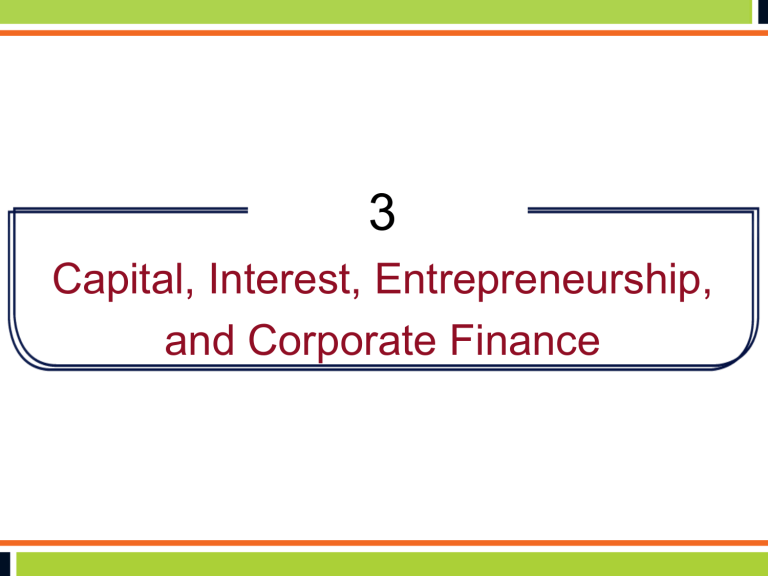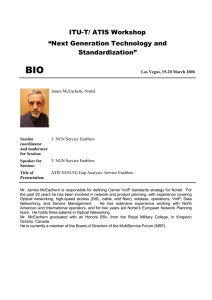
McEachern, Economics 11e, Ch. 13 3 Capital, Interest, Entrepreneurship, and Corporate Finance Prepared by: V. Andreea Chiritescu, Eastern Illinois University Reviewed by: William A. McEachern, University of Connecticut Production, Saving, and Time • Production cannot occur without prior saving – Because production takes time • During which goods and services are not available from current production – Production needs capital – Producers can also borrow funds McEachern, Economics 11e, Ch. 13 Consumption, Saving, and Time • Consumers – Have a positive rate of time preference – Willing to pay more to consume now • Impatience • Uncertainty – Interest • Reward for postponing consumption McEachern, Economics 11e, Ch. 13 Consumption, Saving, and Time • Positive rate of time preference – Consumers value present consumption more than future consumption – People must be rewarded to postpone consumption – Explained by impatience and uncertainty • Interest rate – Interest per year as a percentage of the amount saved or borrowed McEachern, Economics 11e, Ch. 13 Optimal Investment • Market economy: specialization and exchange – Purchase capital with borrowed funds • Firms buy new capital goods – If they expect this investment to yield a higher return than other possible uses of their funds McEachern, Economics 11e, Ch. 13 Optimal Investment • Expected rate of return on capital – Expected annual earnings divided by capital’s purchase price • Market interest rate – Opportunity cost of investing in capital – The marginal cost of investing in capital • Maximize profit – Increase investment as long as expected rate of return > market interest rate McEachern, Economics 11e, Ch. 13 Exhibit 1 Expected Rate of Return on Golf Carts and the Opportunity Cost of Funds Interest rate (percent) 25 Expected rate of return 20 15 10 8 5 Market rate of interest Investment 0 $5,000 $10,000 $15,000 $20,000 $25,000 An individual firm invests in any project with an expected rate of return that exceeds the market interest rate. At an interest rate of 8 percent, Hacker Haven invests $15,000 in three golf carts. McEachern, Economics 11e, Ch. 13 Optimal Investment • Downward-sloping demand curve for investment (individual industries) – More is invested when the opportunity cost of borrowing is lower • Investment demand curve for the entire economy – Downward sloping McEachern, Economics 11e, Ch. 13 The Value of a Good Idea: Intellectual Property • Intellectual property – Intangible assets created by human knowledge and ideas – Costly to create – Once created, can be reproduced at low cost • Patent – Establishes property rights to an invention or other technical advances McEachern, Economics 11e, Ch. 13 The Value of a Good Idea: Intellectual Property • Copyright – Confers property rights to an original expression of an author, artist, composer, or computer programmer • Trademark – Establishes property rights in unique commercial marks and symbols McEachern, Economics 11e, Ch. 13 The Value of a Good Idea: Intellectual Property • Enforcing property rights is costly – Diminished incentive to create new products • Pirated videos, music, computer games, software – No royalties to artists – No wages to industry workers – No profits to producers, programmers – No taxes to government McEachern, Economics 11e, Ch. 13 The Value of a Good Idea: Intellectual Property • Between 2000 and 2014, – Music-industry revenue dropped 50% • Sharing music files: not a victimless crime – Since 2000, more than one-fourth of music industry workers lost their jobs • Most musicians – Earn more from touring than from recordings McEachern, Economics 11e, Ch. 13 The Value of a Good Idea: Intellectual Property • Intellectual property – Intangible asset that fuels the digital economy • Economic development across the globe – Affected by the way society nurtures • Incentives to create new ideas • Inventions • Artistic creations McEachern, Economics 11e, Ch. 13 The Market for Loanable Funds • Demanders of loans – Entrepreneurs borrow to: • Start firms • Invest in physical and intellectual capital • Increase investment until expected marginal rate of return = market interest rate – Households borrow to: • Increase present consumption • Invest in human capital McEachern, Economics 11e, Ch. 13 Demand for Loanable Funds • Demand for loanable funds – Negative relationship between market interest rate and quantity of loans demanded – Declining marginal rate of return – Other things constant • Prices of other resources; Technology • Expected rate of inflation; Tax laws • Customs and conventions of the market McEachern, Economics 11e, Ch. 13 Supply of Loanable Funds • Supply of loanable funds – Banks and other financial institutions are financial intermediaries – Positive relationship between market interest rate and quantity of savings supplied – Other things constant • Expected rate of inflation • People’s retirement plans McEachern, Economics 11e, Ch. 13 Market Interest Rate • Loanable funds market – Savers (suppliers of loanable funds) – And borrowers (demanders of loanable funds) – Come together to determine • Market interest rate • Quantity of loanable funds exchanged McEachern, Economics 11e, Ch. 13 Exhibit 2 Market for Loanable Funds Interest rate (percent) S 9 8 D′ D 0 1.0 1.1 Loanable funds per year (trillions of dollars) Because of the declining expected rate of return on capital, the quantity of loanable funds demanded is inversely related to the interest rate. The market rate of interest, 8 percent, is found where the demand curve for loanable funds intersects the supply curve of loanable funds. An increase in the demand for loanable funds from D to D′ raises the market interest rate from 8 percent to 9 percent and increases the equilibrium quantity of loanable funds from $1.0 to $1.1 trillion. McEachern, Economics 11e, Ch. 13 Why Interest Rates Differ • Prime rate – Interest rate lenders charge their most trustworthy business borrowers • Collateral – Asset pledged by the borrower • Can be sold to pay off the loan in the event the borrower defaults • Term structure of interest rates – Relationship between the duration of a loan and the interest rate charged McEachern, Economics 11e, Ch. 13 Why Interest Rates Differ • Risk – The more valuable the collateral, the lower the interest rate • Duration of the loan – Interest rate increases with the duration of the loan • Administration costs as percent of loan – Decrease as size of the loan increases • Tax treatment McEachern, Economics 11e, Ch. 13 Exhibit 3 Interest Rates Charged for Different Types of Loans Interest rates are higher for riskier loans. Rates for home mortgages and new cars are relatively low because these loans are backed up by the home or car as collateral. Personal loans and credit card balances face the highest rates, because these loans are riskier—that is, the likelihood borrowers fail to repay the loans is greater and the borrower offers no collateral. McEachern, Economics 11e, Ch. 13 Present Value and Discounting • Present value – The value today of income to be received in the future • Discounting – Converting future dollar amounts into present value McEachern, Economics 11e, Ch. 13 Present Value and Discounting • Present value of payment one year hence – Amount received one year from now divided by (1 + interest rate) – The higher the interest rate • The more any future payment is discounted • The lower its present value McEachern, Economics 11e, Ch. 13 Present Value and Discounting • Present value, PV, for payments in later years – Present value of M dollars received t years from now is M divided by (1+ interest rate)t • Receive M dollars • t years from now • Interest rate i – PV smaller for higher t M PV = t (1 + i ) McEachern, Economics 11e, Ch. 13 Present Value and Discounting • Present value of an income stream – Is the sum of present value of each receipt – Example: to receive $100 next year and $150 year after next, for i = 5% • Present value is $100 divided by (1 + interest rate) + $150 divided by (1 + interest rate)2 $100 $150 PV = + = $231.29 2 1.05 (1.05) McEachern, Economics 11e, Ch. 13 Present Value and Discounting • Annuity – A given sum of money received each year for a specified number of years • Present value of an annuity – Perpetuity – if continues indefinitely – Present value of receiving M dollars each year forever is M divided by the interest rate M = i McEachern, Economics 11e, Ch. 13 Entrepreneurship • Entrepreneur – Comes up with an idea – Turns that idea into a marketable product • Obtains the financial capital needed to start or expand the business • Brings together the necessary resources to produce and market the product – Accepts the risk of success or failure – Residual claimant: claims any resulting profit or loss McEachern, Economics 11e, Ch. 13 Entrepreneurship • Entrepreneur – Must have the authority to hire and fire the manager – Drives the economy forward • New products, improve existing products • New production methods • New ways of doing business • Not entrepreneurs – Corporate inventors; managers; stockholders McEachern, Economics 11e, Ch. 13 Corporate Finance • Corporation is a legal entity – Owned by stockholders • Liable only to the extent of their investment in the firm – May own property – May earn profit – May sue or be sued – May incur debt – May be found guilty of a crime McEachern, Economics 11e, Ch. 13 Corporate Stock • Corporations fund investment – Issue and sell stock – Retain some of their profits – Borrow • Initial public offering, IPO – Initial sale of corporate stock to the public • Corporate stock – Certificate reflecting part ownership of a corporation McEachern, Economics 11e, Ch. 13 Corporate Stock • Corporations pay – Corporate income taxes on any profit – Dividends to shareholders • Dividends – After-tax corporate profit paid to stockholders – Rather than retained by the firm and reinvested McEachern, Economics 11e, Ch. 13 Retained Earnings • Retained earnings – After-tax corporate profit reinvested in the firm – Rather than paid to stockholders as dividends – Help the firm grow McEachern, Economics 11e, Ch. 13 Corporate Bonds • Corporations acquire funds by – Issuing stock – Retaining earnings – Borrowing • Bond – Certificate reflecting a firm’s promise • To pay the lender periodic interest • And to repay the borrowed sum of money on the designated maturity date McEachern, Economics 11e, Ch. 13 Corporate Bonds • Bond – Less risky to own than are stocks – Risks • Corporate bankruptcy • Higher market interest rate • Corporations – Issue more bonds when interest rates are low • Because their interest payments on those bonds will be low McEachern, Economics 11e, Ch. 13 Securities Exchange • Securities exchange – Secondary market for securities – Regulated by SEC, Securities and Exchange Commission • New York Stock Exchange – Largest securities market in the world – Trades the securities of about 2,800 major corporations • Including about 500 non-U.S. companies McEachern, Economics 11e, Ch. 13 Securities Exchange • Major U.S. exchanges – More than 5,000 corporations • Network of brokers, over-the-countermarket – Another 10,000 corporations • Publicly traded corporations – Traded on major exchanges and over the counter McEachern, Economics 11e, Ch. 13 Securities Exchange • 6 million much smaller corporations – Not publicly traded – Shares are individually owned by families or just a few stockholders • 21 million sole proprietorships • 3 million partnerships McEachern, Economics 11e, Ch. 13 Securities Exchange • The 15,000 publicly traded corporations – Are just a fraction of 1 percent of all businesses – Account for the overwhelming share of employment and sales in the U.S. • Institutional investors – Banks, insurance companies, and mutual funds – Account for most of the trading volume on major exchanges McEachern, Economics 11e, Ch. 13 Securities Exchange • Exchanges – Enhance the liquidity of securities – Hedge funds • Complex strategies to invest for institutions and for wealthy clients – Determine the current market value of the corporation • Share price times the number of shares issued • The share price reflects the present value of the discounted stream of expected profit McEachern, Economics 11e, Ch. 13 Securities Exchange • Crowdfunding – Raising money from many people through an online platform – Kickstarter • Economists talk about investing – Purchases of new capital • New machines and new buildings • When the media talk about investing – Usually mean buying stocks and bonds McEachern, Economics 11e, Ch. 13


